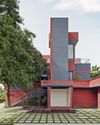
PROJECT: Jiaxing Train Station, Jiaxing, China; ARCHITECTS: MAD Architects
As the urbanization of China in recent years has recently developed, so too has the hardware and technology development related to transportation infrastructure. The corresponding transportation facilities buildings, such as railway stations and new airports, however, have not improved their spatial and architectural qualities at the same rate. Train stations have instead grown far beyond the human scale, standing like imposing palaces in Chinese city centers surrounded by wide main roads, viaducts, and vast empty squares.
In response to this common trend, MAD founding partner Ma Yansong advised that “we should rethink and redefine the spatial patterns of such transportation infrastructure buildings in China. We can break away from the common pursuit of grandiose monumental buildings and make them urban public spaces with transport functions, natural ecology and cultural life, where citizens are happy to go, stay, meet, and enjoy.”
A new sunken train station designed with a human scale
Jiaxing Train Station was first built in 1907 and was destroyed over half a century ago. The station that was constructed in 1995 to replace the original station had an area of only 4,000 square meters and was equipped with outdated passenger facilities unsuitable for a rapidly expanding city.
MAD’s design breaks away from the usual pursuit of monumental transportation structures with a full-scale recreation of the original 1907 station, as well as a “floating” metal roof lofted above the expanded site equipped with solar panels that power the station.
Diese Geschichte stammt aus der February 2024-Ausgabe von Architecture + Design.
Starten Sie Ihre 7-tägige kostenlose Testversion von Magzter GOLD, um auf Tausende kuratierte Premium-Storys sowie über 8.000 Zeitschriften und Zeitungen zuzugreifen.
Bereits Abonnent ? Anmelden
Diese Geschichte stammt aus der February 2024-Ausgabe von Architecture + Design.
Starten Sie Ihre 7-tägige kostenlose Testversion von Magzter GOLD, um auf Tausende kuratierte Premium-Storys sowie über 8.000 Zeitschriften und Zeitungen zuzugreifen.
Bereits Abonnent? Anmelden

A GRECIAN RETREAT
Shimona Bhansali imbues a subtle touch of opulence to this home in Mumbai

A BOLD STATEMENT
Dhampur Sugar Mills Limited's workspace in New Delhi designed and built by Officebanao adopts an industrial narrative

A BREATH OF FRAGRANT DESIGN IN DELHI'S HEART
An office that smells like perfumery; that is the vision that TWI brought to life in this office space designed for an acclaimed perfume company in India

MASTER OF ALL TRADES
The ethos of forward-thinking and ingenuity finds its architectural counterpart within the walls of Nikhil Kamath and Abhijeet Pai's office-a vision of organic design infused with the essence of India

A TOUCH OF OPULENCE
Designed by Aparna Kaushik, this Delhi office displays an interesting balance of classic aesthetics and contemporary sensibilities

THE WOODEN WONDERLAND
Priyanka and Piyush Mehra envision a stunning experience centre for Vikas Plywood

THE HUB: BUILDING COMMUNITIES
Studio Lotus designs a dynamic mixed-use community hub that activates Chennai's largest IT Park

THE WINNER'S PERCH
Baldiwala Edge designs a Singapore-based ship broker's office as a torch collector's paradise, offering a 360-degree bird's-eye view of the Mumbai skyline

THE DIRECTOR'S CABIN
Designed by Envisage, this office gives a new definition to the traditional notion of biophilia

Designing Corporate India
From weaving the magic of a Star Trek-themed command centre to crafting bespoke block-printed workstations, Vijaya Bhargav and Arnab Ghosh-the trailblazing co-founders of Ostraca-have astonishingly transformed a staggering 29 million square feet of office space for India's tech giants and global enterprises-all while maintaining a flat hierarchical company culture-fuelling a master class in corporate design